

TU Delft Institutional Repository. Visualizing Density. When you think of high density housing what comes to mind?
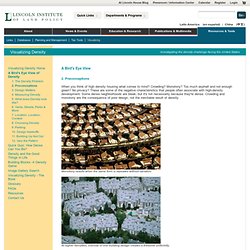
Crowding? Monotony? Too much asphalt and not enough green? No privacy? These are some of the negative characteristics that people often associate with high-density development. Monotony results when the same form is repeated without variation. At higher densities, overuse of one building design creates a tiresome uniformity. Shifting the building orientation does not provide sufficient variety or privacy. 20 Outstanding & Outrageous Concept Cars from the Golden Age : WebUrbanist. Shining Examples: 20 Cool Concept Cars of the Golden Age Article by Steve, filed under Vintage & Retro in the Technology category.

Abstract. Urban growth generates nowadays patterns, which look rather irregular.

Planning policy regrets the lack of compactness and density of these agglomerations, but controlling urban sprawl turns out to be difficult. Obviously a new type of spatial organisation emerges, which is rather the result of a self-organisation process to which a high number of social agents contribute. Minnesota Population Center. Urban Fabric & Form Comparison. The Star today published a cover story (Beyond Density) in their Condos section on the efforts in Mississauga to create a more vibrant and pedestrian-friendly downtown – key among the problems identified has been the large scale of the block patterns in Mississauga – to prove the point the article includes urban form/fabric drawings of 9 cities (one hopes at the same scales) in order to compare the scales of the fabric of the street network.
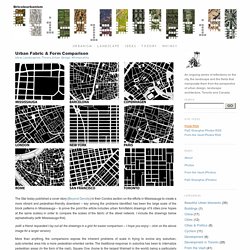
I include the drawings below alphabetically (with Mississauga first). (edit: a friend requested I lay out all the drawings in a grid for easier comparison – I hope you enjoy – click on the above image for a larger version) More than anything, the comparisons expose the inherent problems of scale in trying to evolve any suburban, auto-oriented area into a more pedestrian-oriented centre.
MISSISSAUGA: “Long blocks and virtually empty sidewalks” Visualizing Density. Gentrification. Gentrification is a shift in an urban community toward wealthier residents and/or businesses and increasing property values.[1] Gentrification is typically the result of investment in a community by local government, community activists, or business groups, and can often spur economic development, attract business, and lower crime rates.
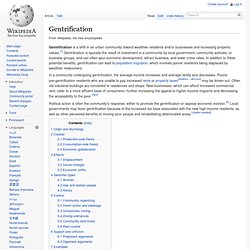
In addition to these potential benefits, gentrification can lead to population migration, which involves poorer residents being displaced by wealthier newcomers. In a community undergoing gentrification, the average income increases and average family size decreases. Poorer pre-gentrification residents who are unable to pay increased rents or property taxes[dubious ] may be driven out. Often old industrial buildings are converted to residences and shops. Urban density. Urban density is a term used in urban planning and urban design to refer to the number of people inhabiting a given urbanized area.
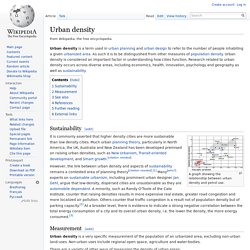
As such it is to be distinguished from other measures of population density. Urban density is considered an important factor in understanding how cities function. Research related to urban density occurs across diverse areas, including economics, health, innovation, psychology and geography as well as sustainability. Sustainability[edit] Summary of the Value of Urban Design - The Value of Density [Ministry for the Environment] ISUF - Urban Morphology - Online Articles 1997-2001. Density inside out. In our research, the concept of density is used to construct a bridge between formal and quantitative properties of urban areas.
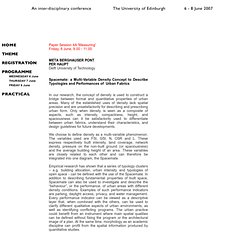
Many of the established uses of density lack spatial precision and are unsatisfactorily for describing and prescribing urban form. Only when density is seen as a composite of aspects, such as intensity, compactness, height, and spaciousness can it be satisfactorily used to differentiate between urban fabrics, understand their characteristics, and design guidelines for future developments.
We choose to define density as a multi-variable phenomenon. The variables used are FSI, GSI, N, OSR and L. These express respectively built intensity, land coverage, network density, pressure on the non-built ground (or spaciousness) and the average building height of an area. Urban density. Urban density and transport-related energy consumption - Maps and Graphics at UNEP/GRID-Arendal.
The GRID-Arendal Maps & Graphics Library is an on-going project to collect and catalogue all graphic products that have been prepared for publications and web-sites from the last 15 years in a wide range of themes related to environment and sustainable development.

There are currently 3022 graphics available in the database. Forest Carbon Sequestration Converting land for biofuel production can cause biodiversity impacts in the short-term, but such conversion also a ects the future resilience of natural ecosystems. Www.uitp.org/publications/brochures/better/pics/solutions-en.pdf. The Death and Life of Great American Cities. The Death and Life of Great American Cities is a 1961 book by writer and activist Jane Jacobs.

The book is a critique of 1950s urban planning policy, which it holds responsible for the decline of many city neighborhoods in the United States.[1] Going against the common wisdom of the age, it proposes new ideas that it says would ensure organic vibrancy in urban America. Contents[edit] In their place Jacobs advocated "four generators of diversity": "The necessity for these four conditions is the most important point this book has to make. In combination, these conditions create effective economic pools of use. " (p. 151) The conditions are: Her aesthetic can be considered opposite to that of the modernists, upholding redundancy and vibrancy against order and efficiency. Legacy[edit] The book continues to be Jacobs' most influential, and is still widely read by both planning professionals and the general public.
References[edit] Bibliography[edit] Www.creativeclass.com/rfcgdb/articles/Urban_Density_Creativity_and_Innovation.pdf. Urban Development, Smart Growth & New Urbanism: Urbanization & Density. Spacemate - Home. The spacemate: Density and the Typomorphology of the Urban Fabric. Miranda-pina.dpa-etsam.com/files/01.Spacemate_Berghauser_haupt.pdf. Urbanism laboratory for cities and ... Books.google.com.co - "The conditions of urban development are currently changing radically.
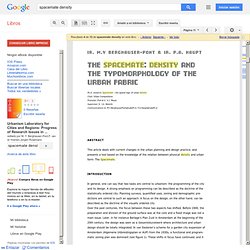
Technological transformations such as automation and robotisation in industrial production are leading to new operating conditions for businesses and employees. The architecture annual 2005-2006 ... Spacemate. Visualizing Density. Sprawl is bad. Density is good. Americans need to stop spreading out and live closer together. Well… that's the theory, anyway. But, as anyone who has tried to build compact development recently will tell you, if there's one thing Americans hate more than sprawl, it's density. Largest cities in the world by population density (1 to 125) Density Using Land Area. Density Using Land Area For States, Counties, Metropolitan Areas, and Places American FactFinder tables (Census 2000 Summary File 1, 100-Percent Data)